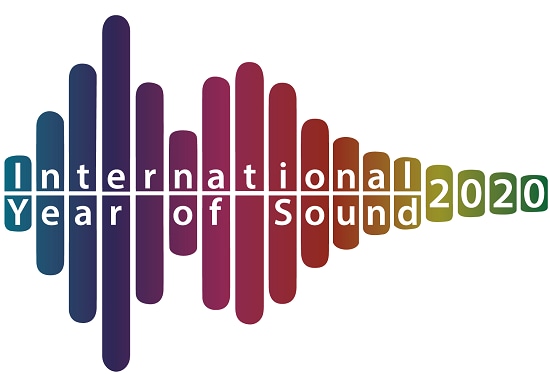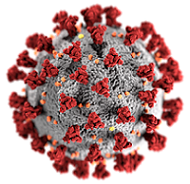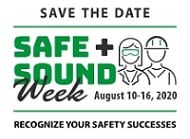NIOSH eNews
Although NIOSH is continuing to share important updates about NIOSH research and activities in our monthly eNews newsletter, we will also be sharing updates about the important work NIOSH is doing to support the COVID-19 response. We are providing additional updates in weekly eNews Flashes to help keep you up to date on the latest CDC and NIOSH COVID-19 information and guidance. We encourage you to share these resources with others who may find this information useful as well.
Volume 17, Number 12 (April 2020)
From the Director’s Desk
John Howard, M.D. Director, NIOSH
International Year of Sound: Wikipedia for the Greater Good
The famous Renaissance adage “scientia potentia est”—knowledge is power—rings as true today as ever. In fact, it underlies the NIOSH mission statement: “To develop new knowledge in the field of occupational safety and health and to transfer that knowledge into practice.” NIOSH products and communication channels are a key part of our effort to make sure workers have the right knowledge to remain safe. However, research showsexternal icon that more people go to Wikipedia for health-related information than any other source. Because of this, NIOSH is leading a campaign called Wiki4YearOfSound2020external icon to make information on acoustics freely available, correct, and up-to-date on Wikipedia.
Wiki4YearOfSound2020 is part of the International Year of Sound 2020 (IYS2020)external icon global initiative, which aims to highlight the significance of sound in daily life. NIOSH is one of many partners in the initiative. NIOSH hopes to use the Wikipedia campaign to raise awareness of noise and its effects by providing occupational hearing loss prevention information. Anyone can participate. Just sign up for a Wikipedia account, join the campaignexternal icon, and then suggest, write, edit, or translate any Wikipedia articles related to acoustics. The campaign’s impact is measurable because Wikipedia will track all contributions completed in 2020.
This is not the first time NIOSH hearing loss researchers have promoted a Wikipedia effort. In March 2019, the team partnered with several other organizations for a month-long campaign: Wiki4WorldHearingDay2019. Over a 2-month period, contributors created 7 new articles and made over 1,000 edits to 90 existing articles. The articles were viewed more than 2.3 million times during the tracking period. Wiki4YearOfSound2020 also looks promising. During the first three months, the campaign dashboardexternal icon has recorded over 277,000 edits and 9.15 million article views.
Wikipedia campaigns are an effective way to increase the accessibility of health and safety information by putting it in a place where many workers will look for it. These campaigns provide a wonderful opportunity to write scientific information in plain language and directly reach the audience that inspires all NIOSH research.
Exposure to Flame-retardants Found Across Industries
Flame-retardant chemicals found in many popular products, such as carpets and furniture, can slow a fire or even prevent it from igniting. Despite this benefit, research shows that workplace exposure to these chemicals during manufacturing or recycling may cause health concerns such as disruption to the immune and reproductive systems, increasing the risk of disease.
In a recent study, investigators looked at exposure to flame retardants among 105 workers representing nine industries that use flame-retardant materials. These industries included carpet installation, chemical manufacturing, foam manufacturing, electronic scrap recycling, gymnastics, rigid board installation, nail salons, roofing, and spray polyurethane foam application and manufacturing. Using air and hand-wipe samples, the investigators measured levels of three classes of flame retardants: organophosphate flame retardants (OFRs), polybrominated diphenyl ethers (PBDEs), and non-PBDE brominated flame retardants (NPBFRs). Although PBDE production has ceased in the United States, previously produced batches of the chemical can still be found in some industries.
Compared to the other flame retardants, OFR concentrations were higher and more widespread in both air and hand-wipe measurements. Workers who used spray polyurethane foam had the highest exposures to OFRs, followed by chemical manufacturers, according to the paper published in the Environment Internationalexternal icon. Overall, levels were highest in polyurethane foam application and manufacturing, chemical manufacturing, nail salons, roofing, and rigid board installation. Although PBDE exposures seemed to be lower than in previous studies, exposure still occurred among carpet installers, electronic scrap workers, and gymnastics workers. Workers in these industries also had exposures to the other two classes of flame retardants tested.
These findings show that air and skin exposure to flame retardants, especially OFRs, is widespread across industries. They underscore the importance of using controls, such as ventilation and enclosure of flame retardants, and personal protective equipment, including gloves and respirators.
Strains and Sprains Lead Work-related Injury Claims in Massachusetts
Massachusetts workers filed workers’ compensation claims between 2014 and 2016 most often for strains and sprains, according to a NIOSH-funded studyexternal icon by the Massachusetts Department of Public Health. Using previously unavailable data from the Massachusetts Department of Industrial Accidents, investigators looked at trends of occupational injuries and illnesses for private sector workers. In particular, they identified common types of incidents leading to these conditions and noted demographics like gender and age, and industry. Investigators analyzed 93,123 workers’ compensation lost wage claims filed during 2014–2016 for employees working at least 40 hours weekly. This equated to an average of 31,041 claims per year.
According to the study, injuries accounted for 95% of all claims, with most of the workers experiencing strains and sprains (51%); contusions, crushings, bruises (12%); fractures (9%); and cuts, lacerations, punctures (8%). Overexertion due to lifting and pushing marked the top cause of all injuries (38%), followed by slips, trips, and falls (29%), contact with an object or equipment (19%), and violence and transportation incidents (5%). Males filed most of the workers’ compensation claims, along with workers aged 55–64 years who most commonly reported being injured from a fall on the same level. Overall, the cause of workers’ injuries varied by age with 25-to-64-year olds having injuries mostly due to overexertion in lifting, pushing, and other hard physical efforts while moving an object or a person. Young workers, aged 16–24 years, were almost as likely to have been injured from lifting and pushing as being struck by objects.
The occupational sectors with the highest claim rates were Transportation and Warehousing, Construction, Healthcare and Social Assistance, and Wholesale and Retail Trade. These findings can help guide research and prevention efforts.
More information is available:

Image source: International Commission for Acoustics.
Director’s Desk
Research Rounds
- Exposure to Flame-retardants Found Across Industries
- Strains and Sprains Lead Work-related Injury Claims in Massachusetts
Highlights
- Update on Coronavirus Disease 2019 (COVID-19) Response
- A Commentary on Expanding the Field of OSH
- Updated Worker Health Charts Makes Data Exploration Easier Than Ever
- NIOSH & Partners Announce Annual Safe + Sound Week
- Learn About the NIOSH EIS Experience
Monthly Features
John Howard, M.D., Director
Christina Spring, Editor in Chief
Managing Editor
Tanya Headley
Section Editors
Anne Blank, Research Rounds
Kiana Harper, Monthly Features
Contributing Editors
Sarah Mitchell
Emily Norton
Donjanea Williams
Copy Editor
Cheryl Hamilton
Technical Support
Steve Leonard, Technical Lead
Tonya White, Web Developer
To receive the NIOSH eNews email newsletter, enter your email address:
Highlights

Update on Coronavirus Disease 2019 (COVID-19) Response
This week, CDC released the following new guidance related to use of personal protective equipment (PPE) and the COVID-19 response:
- Personal Protective Equipment (PPE) Burn Rate Calculator – helps healthcare and nonhealthcare systems, such as correctional facilities, track how quickly personal protective equipment (PPE) will be used at their facilities. The calculator can be used to assist facilities to plan and optimize the use of PPE for response to COVID-19. CDC is working with partners across the global supply chain to evaluate and respond to reported shortages in PPE.
- Decontamination and Reuse of Filtering Facepiece Respirators Using Contingency and Crisis Capacity Strategies – provides a summary of relevant research on potential methods of decontaminating NIOSH-approved filtering facepiece respirators for reuse.
- Strategies for Optimizing the Supply of PPE – highlights some of the strategies to approach this issue, including information on eye protection, isolation gowns, facemasks, and N95 respirators.
In addition to these materials, a number of interim guidance documents are available for businesses and employers, healthcare settings, and first responders. You can also stay up to date on the response on the COVID-19 webpage or sign up for the COVID-19 newsletter.
A Commentary on Expanding the Field of OSH
A recent commentaryexternal icon by NIOSH leadership and grantees discusses the idea of expanding the focus on traditional indicators of occupational safety and health (OSH) to better prepare for and respond to issues relevant to worker safety, health, and well-being. The commentary, published in the International Journal of Environmental Research and Public Health, identifies solutions for employers and workers to address the changes that will challenge traditional OSH systems.
Updated Worker Health Charts Makes Data Exploration Easier Than Ever
NIOSH recently deployed a new release of the Worker Health Charts that includes user experience enhancements to the query and filtering functions to make them faster and more responsive. Read more on the NIOSH Worker Health Charts webpage.

NIOSH & Partners Announce Annual Safe + Sound Week
Save the date for Safe + Sound Week 2020external icon, August 10–16. This is a week-long nationwide event held each August by NIOSH, OSHA, and many other partners that recognizes the successes of workplace safety and health programs and offers information and ideas on how to keep America’s workers safe. All organizations looking for an opportunity to recognize their commitment to safety are welcome to participate.
Learn About the NIOSH EIS Experience
The Epidemic Intelligence Service (EIS) is a two-year, post-graduate training program in applied epidemiology at CDC. As part of CDC, NIOSH offers opportunities for new EIS officers in occupational safety and health. Learn more on our updated EIS webpage or watch a short videoexternal icon about the NIOSH EIS experience.
Monthly Features
New Communication Products & Reports
FACE Reports
- Truck Mechanic Pinned by Truck’s Sway Bar and Link—Michigan
- Volunteer Mowing Grass Pinned by Overturned Tractor—Michigan
- Sewer Administrator Died when Chop Saw Spark Caused a 55-Gallon Drum to Explode—Michigan
- Farmer Died when He Fell From a Ladder—Michigan
- Tree Trimmer Working in Tree Died when a Tree Branch Supporting Rigging Rope Broke Below the Crotch and Struck His Head—Michigan
Fact Sheet
Health Hazard Evaluation Reports
- Evaluation of Potential Unintentional Illicit Drug Exposure at a County Jailexternal icon
- Evaluation of Ergonomics, Dust, and Unanticipated Hazards at a Donation and Retail Storeexternal icon
Posters
- 3D Printing with Metal Powders: Health and Safety Questions to Ask
- 3D Printing with Filaments: Health and Safety Questions to Ask
- Row House Firefighting Tactics Poster
Report
Website
NIOSH Science Blog
- Proper N95 Respirator Use for Respiratory Protection Preparedness
- ‘Take-Home’ Exposures Still Persist
- The Need for Fit Testing During Emerging Infectious Disease Outbreaks
Federal Register Notice
Proposed Data Collection Submitted for Public Comment and Recommendations: Health Hazard Evaluations/Technical Assistance and Emerging Problems
The noticeexternal icon was posted on February 10. Comments must be received by April 10.
Solicitation of Nominations for Appointment to the Board of Scientific Counselors (BSC), National Institute for Occupational Safety and Health (NIOSH)
The noticeexternal icon was posted on March 25. Comments must be received by April 20.
Proposed Data Collection Submitted for Public Comment and Recommendations: Occupational Driver Safety at Intersections
The noticeexternal icon was posted on February 25. Comments must be received by April 27.
Proposed Data Collection Submitted for Public Comment and Recommendations: Heat-related Changes in Cognitive Performance
The noticeexternal icon was posted on February 25. Comments must be received by April 27.
Proposed Data Collection Submitted for Public Comment and Recommendations: Understanding Long-term Respiratory Morbidity in Former Styrene-exposed Workers
The noticeexternal icon was posted on February 28. Comments must be received by April 28.
Coal Workers’ Health Surveillance Program: B Reader Decertification and Autopsy Payment
The noticeexternal icon was posted on February 14. Comments must be received by May 14.
Research Project to Evaluate and Control Hazards to Landscaping and Grounds Management Workers; Request for Participants
The noticeexternal icon was posted on January 10. Letters of interest must be received by October 16.
National Occupational Research Agenda (NORA)
Call for Submissions for NORA Public Safety Council Meeting
The NORA Public Safety Sector (PSS) Council will hold a virtual meeting on July 29 from 11 a.m. to 2 p.m. (EDT). Researchers and innovators will present their work to Council members to (1) obtain technical feedback, (2) identify potential study collaborators, and (3) facilitate broader dissemination of findings and products of their research. Interested researchers and innovators should reach out to the NORA PSS Assistant Coordinator, Tyler Quinn, for topic submission instructions—submissions are due by May 1.
News from Our Partners
Germ-fighting Fabric Developed for Healthcare Settings
Scientists at the University of Massachusetts Lowell recently announcedexternal icon the development of a germ-killing fabric for use in the healthcare field that could possibly prevent the spread of communicable diseases. NIOSH funded this studyexternal icon through its Exploratory Grant Program (R21).
Task Force Releases Final Recommendations for Hepatitis C Screening in Adolescents and Adults
The U.S. Preventive Services Task Force (USPSTF) released a final recommendation statement on screening for hepatitis C virus infection in adolescents and adults. USPSTF concluded that clinicians should screen all adults for hepatitis C infection. Read the recommendation and the evidenceexternal icon that it is based on.
CDC Public Health Associate Program Seeks Host Sites
The CDC Public Health Associate Program (PHAP) is accepting host site applications April 1–14. PHAP is seeking host sites that can host an associate from October 2020 to October 2022. PHAP relies on its partnerships with public health agencies and tribal and nongovernmental organizations to serve as host sites for public health associates. These relationships are vital to the development of our nation’s next generation of public health professionals. And, the benefits to host sites are invaluable. Learn more on the PHAP webpage where webinars are also available with more information.
Webinars, Conferences & Events
Call for Submissions
NORA Public Safety Council Meeting
Topic submissions for the NORA public safety council meeting are due May 1. Contact Tyler Quinn for instructions and more information.
Upcoming Meetings
NORA Public Safety Sector Council Meeting
July 29, 11 a.m.—2 p.m. (ET). Contact Tyler Quinn for more information.
Upcoming Webinars
NIOSH Education and Research Centers Industrial Hygiene Webinar Series 2020: Creative Use of Direct Reading Instrumentsexternal icon
April 7, 3–4 p.m. (EDT). Contact Donjanea Williams for more information.
Fall Prevention & Protection in the Roofing Industryexternal icon
April 16, 1–2 p.m. (EDT). Contact Elizabeth Garza for more information.
Virtual National Stand-Down to Prevent Struck-by Incidents – Q&A Panelexternal icon
April 20, 2–3 p.m. (EDT). Contact Alan Echt for more information.
NIOSH Education and Research Centers Ergonomics Webinar Series 2020: Lean Ergonomics: It’s an Efficiency Issueexternal icon
April 22, 3–4 p.m. (EDT). Contact Donjanea Williams for more information.
Upcoming Conferences
World Health Organization Health for All Film Festivalexternal icon
May 16–22, Geneva, Switzerland
American Industrial Hygiene Conference & Expositionexternal icon
June 1–3, Atlanta, Georgia
VPPPA Safety Conferenceexternal icon
July 20–24, Mount Pocono, Pennsylvania
National Conference on Health Communication, Marketing & Media
August 10–12, Atlanta, Georgia
XXII World Congress on Safety and Health at Workexternal icon
October 4–7, Toronto, Canada
International Media Festival for Preventionexternal icon
October 4–7, Toronto, Canada
American Public Health Association Conferenceexternal icon
October 24–28, San Francisco, California
